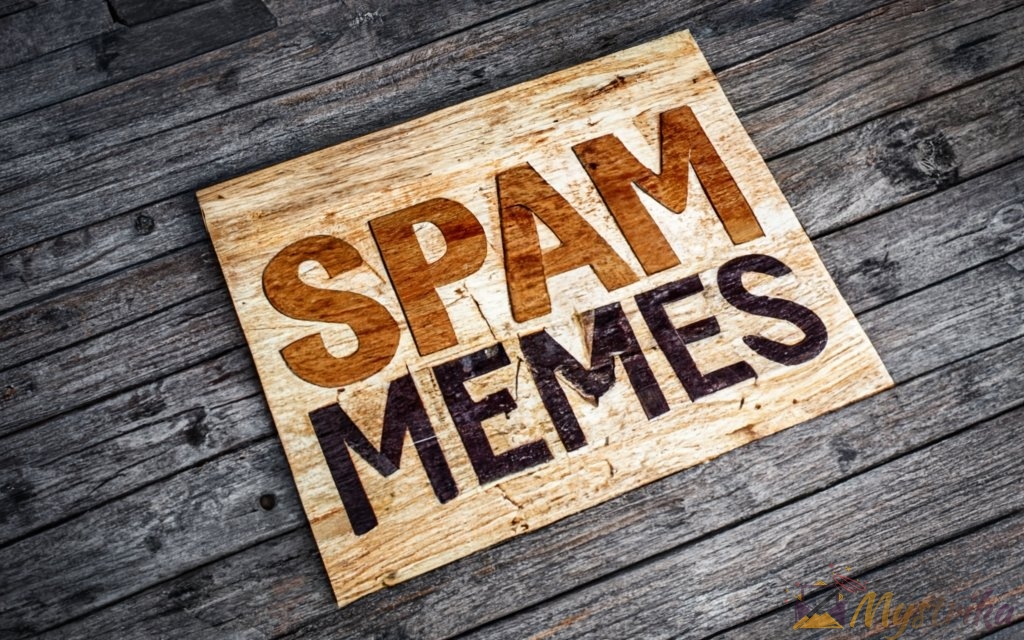From Monty Python to your overflowing inbox, here’s the weird story behind everyone’s favorite internet annoyance – spam memes! Learn about these iconic relics of online history and their enduring appeal.
A Brief History of Spam and How It Became an Internet Meme
The term “spam” is now deeply ingrained in internet culture, universally representing unwanted or junk messages. But how did canned meat from a 1970s Monty Python sketch become synonymous with one of the web’s biggest nuisances? This strange evolution provides a fascinating lens into the early days of internet culture and online behavior.
Origins of the term “spam” in a 1970 Monty Python sketch
The use of the word “spam” to refer to unwanted messages originates from a legendary 1970 sketch by the British comedy troupe Monty Python’s Flying Circus. In the sketch, a group of vikings sings a chorus about Spam, the canned luncheon meat made by Hormel Foods. As they sing the chorus “Spam, Spam, Spam…” a patron tries ordering a spam-free meal at a cafe, only to be drowned out by the singers repeating “Spam” loudly and obnoxiously.
The skit was absurdist humor mocking how Spam was almost unavoidable in British diets at the time. This satire of the product’s popularity clearly struck a chord with early internet users. When communication systems like chat rooms and bulletin boards were flooded with repetitive, unwanted messages, users likened it to the sketch’s aggressive Spam chorus.
Early internet users flooding chatrooms with the word “spam”
The first documented use of the term “spam” to refer to unwanted online messages dates back to 1993 on Usenet groups.
In this nascent era of the internet, online communities and communication systems were still figuring out norms and etiquette. “Spamming” a chatroom or message board with repetitive text or gibberish was an early form of online trolling. Just like the Monty Python singers obnoxiously chanting “Spam,” flooding forums with the same word was an attempt at humor through absurdity and annoyance.
Early internet chat and message systems were quickly overwhelmed by users spamming them with repetitive words and phrases. These pioneering trolls found that Monty Python’s use of “Spam” was a perfect choice for filling chatrooms with meaningless text. The term was quickly adopted as shorthand referring to any unsolicited repetitive messages on the internet.
By the mid 90s, Usenet FAQs formally defined spamming as “inappropriate mass posting.” The internet’s spam problem had been clearly identified. Next, it evolved again into what we know as email spam.
Adoption of “spam” to mean junk emails or messages
As email grew in the 90s, it didn’t take long for enterprising users to seize on it as a new medium for spamming. Junk mail” and “bulk emails” referred specifically to this flood of unsolicited email. But users increasingly referred to them as “spam,” harkening back to the early chatroom spamming.
A 1994 post on the Usenet newsgroup alt.folklore.computers announced that “Spamming is becoming a general synonym for various kinds of network abuse and annoyance.” By the late 90s, spam was cemented as universally understood internet slang for any undesired, excessive online messages.
The first mass spam messages selling dubious products started spreading like wildfire. Technological innovations meant automated spamming bots could blast untold amounts of email spam. Predictions of email’s demise due to the spam onslaught spread. To solve the crisis, the U.S. passed the 2003 CAN-SPAM act to regulate commercial email and combat spam’s scourge.
How internet memes helped popularize spam jokes and images
In the early 2000s, spam was intertwined with the emerging internet culture of memes. As memes like LOLcats and Rickrolling took off, they often contained references to spamming or avoiding spam. Early meme sites like 4chan were flooded with spam just like old 90s chatrooms.
Memes using the Monty Python Spam sketch also started popping up, coming full circle back to the original use of the term. Images of the canned meat product or spam-filled Monty Python scenes with jokes playing off the many meanings of “spam” became popular online.
As memes spread across the internet and social media, spam jokes and imagery resurged alongside other early internet nostalgia. The legacy of Monty Python’s Spam had truly embedded itself in the very fabric of online communities and culture.
Today, references to spam are deeply ingrained in the languages and customs of the internet. This ubiquitous internet nuisance can be traced back to its roots in the luncheon meat-loving vikings belting out their absurd ditty. While email providers filter out most spam automatically now, meme culture ensures that humor at the expense of spam lives on eternally.

The Cultural Impact and Significance of Spam Memes
Beyond just cheap laughs, spam memes and jokes reveal a lot about our complex relationship with digital communication. They represent more than just the annoyance of unwanted emails and messages in inboxes. Spam memes provide insight into the history and sociology of online communities.
Spam memes represent broader annoyance with unwanted online communication
Beyond a specific definition, “spam” represents something unwanted injected into discourse where it doesn’t belong. Spam memes channel a collective frustration with the constant intrusion of undesired messages in online spaces.
The internet was envisioned as an open egalitarian forum, but also one with limited space and resources. Spam represents waste and abuse of these digital commons. Anti-spam advocates argued that flooding online spaces diminished freedom of expression.
Spam memes symbolize this concern about excessive noise drowning out meaningful conversation. They express frustration about the struggle to filter signal from noise when anyone has an open mic in online communities.
Polls constantly show huge majorities of internet users annoyed by spam in their inboxes and online. Spam memes visualize this sentiment in humorous ways, but also signify a real desire for online spaces with relevant discussion.
Spam memes used as a weapon to overwhelm online communities
Spam meme humor also enables anonymized aggression within internet culture wars. Organized trolling efforts use spam attacks to disrupt rival online communities.
Image board users flood forums with off-topic content and spam to undermine conversation. Comment sections devolve into spam wars between factions looking to sabotage discussion. Raids spam sites and hashtags with content designed to overwhelm and obstruct their usefulness.
These attacks highlight the internet’s vulnerability to organized mob action. Spam memes based on these tactics allow aggressors to pontificate about defending online communities while hypocritically weaponizing spam to attack them. They rationalize objectionable behavior as a necessary response to hostile groups or ideologies.
Under the guise of irony, spam meme raids expose the callous dehumanization that often motivates online harassment mobs. The jokes provide thin cover for toxic behavior violating norms of decorum and respect for online spaces.
Spam memes allow people to laugh at the constant presence of spam
On a lighter note, spam memes help internet users cope with the perpetual onslaught of spam. Email spam filters now catch most junk automatically. But endless spam remains embedded in sketchy ads, obtrusive website pop-ups, and abundant internet scams.
Having a laugh at the absurd extremity of spam provides catharsis. Spam memes let people bond over frustrations with spam’s omnipresence in the online experience. They transform annoyance into amusement.
This humor highlights resilience and maintains sanity in the face of rampant online nuisances. The ability to joke about adversities like spam represents the irreverent spirit and optimism of internet culture. Spam memes sustain positivity and community by poking fun at a common enemy.
Spam memes connected to larger internet history and culture
On a broader level, spam memes relate to nostalgia for the early internet days. Veteran users feel a strange fondness for the old wild west era, before massive consolidation and homogenization of online space.
Revisiting silly early internet traditions like spamming recalls this more open and decentralized web 1.0 landscape. Reminiscing about chaotic old chatrooms and spam-filled inboxes evokes wistful nostalgia for the adventure and lawlessness of the early online frontier.
Looking back on the spam issue spotlights how the familiar modern internet emerged from peculiar local customs and growing pains as diverse online communities fused into a common digital culture. The layers of meaning and references in spam memes encapsulate this evolutionary history of the net.
So the next time you shake your fist and chuckle at a spam meme, appreciate how this digital relic reveals so much about the internet’s story and social fabric!

The Top Spam Memes Throughout the Years
Spam memes have evolved across internet generations, adapating alongside changes in technology and communication mediums. Some spam meme formats directly reference the Monty Python origins, while others reinvent spam satire for modern contexts. The top categories demonstrate spam’s timeless humor and relevance.
Monty Python Spam Sketch Memes
The most direct spam memes use scenes, characters, and products directly from the 1970 Monty Python sketch that started it all. These memes tend to be most popular with older internet generations or hardcore Monty Python fans familiar with the original source.
Classic images show the lyric “Spam, Spam, Spam…” in impact font overlaid on the singing vikings. Close-up portraits of the Spam tin or Terry Jones in drag as a Spam-obsessed waitress also recur. Comics relate modern nuisance messages to the aggressive Spam chorus overwhelming the cafe patron.
Part of the appeal comes from the surreal absurdity of the sketch itself. But the most effective Monty Python spam memes use specific references to cleverly link the canned meat to modern internet content overload.
Spam Email Memes
Email cemented “spam” as a term for any unwanted online message. Spam email memes represent the most abundant and relatable category, resonating with anyone who has an inbox.
Gags mock the penile enhancement and Nigerian prince scams associated with early internet spam. Visually burying characters under mountains of spam messages conveys the overwhelming onslaught. Images of characters raging at spam convey frustration known all too well.
Relatable memes joke about misspelling email replies and sending emails to the wrong recipients. The awkwardness of unsubscribing from spam without offending marketers inspired funny takes. In the social media age, memes equated notifications and messages from random acquaintances to bothersome spam clogging the feed.
Spam as a Weapon Memes
Spam memes mocking coordinated spam attacks represent a more sinister side of internet culture. Pranks and raids flooding sites, forums, and comments sections with repetitive text or gibberish are portrayed as smug trolling.
Dark humor memes based on these abrasive tactics often use slogans about defending internet freedom or drowning out toxicity. They justify mob spam tactics as activism against antagonistic groups. This rationalizes harassment as just ironic play, obscuring real impacts.
Other memes satirize organizations like 4chan that historically encouraged spamming rival forums. Posts portraying spam as warfare spotlight this adversarial side of internet tribalism beneath superficial lightheartedness. But most just revel in mischief, without deeper examination.
SEO/Content Creator Spam Memes
With “spam” so deeply rooted in internet vernacular, overuse as forced slang tends to draw snarky memes. Keyword stuffing posts to chase SEO are mocked for painfully repetitive mentions of “spam.” Spam memes also satirize themselves through recursive self-references, joking about spamming content about spam. Even instructional spam memes provoke irony about contributing to spam oversaturation.
These memes highlight how the internet rapidly co-opts and drains novel concepts through meme feedback loops. “Meta” commentary on memes about spam memes becoming their own stale cliche represents a microcosm of the constant churn of internet culture. Nothing remains “fresh” for long!

Why Spam Memes Have Endured in Pop Culture
On the surface, spam seems like an outdated annoyance that modern filtering should have eliminated. But spam memes and jokes show no sign of slowing down. The reasons these cultural artifacts have such lasting appeal reveal profound truths about human nature and our relationship with technology.
The timeless annoyance of spam emails and messages
However advanced tools for blocking spam get, it always finds new ways to seep through the cracks. Spam thrives on exploiting any possible channels from social media to texts to pop-ups. The continuing nuisance means the core frustration at the heart of spam memes remains relevant.
No matter how polished and polished digital communication gets, it still gets cluttered with junk. Spam memes channel that inevitability of encountering annoying intrusions that diverge from our ideal online experience. Dissatisfaction and annoyance will never disappear, and neither will the need to vent through humor.
Nostalgia for the early internet days
Spam memes also tap into warm remembrances of the old lawless internet frontier. Veterans feel nostalgia for the gritty pioneering days when norms were up for grabs. Younger users enjoy the novelty of early chaotic online communities.
Looking back at spam flooding rough-and-tumble 90s chatrooms and inboxes evokes nostalgic feelings for the web’s eccentric formative years. The innocence of early networks overrun with well-meaning spam aligns with widespread appetite for reminiscing about retro technology eras.
Shared experience of digital communication
On some level, spam memes represent inside jokes about universally familiar aspects of digital life. We all rely on emails, social networks, and devices riddled with comment sections. Experiencing various forms of spam links us in a common modern condition.
This bonding over mutual headaches like spam inboxes builds community and connection. Shared pains foster camaraderie, as coping through laughs affirms we’re all in this together. Memes express that we take solace in company, commiserating about the small daily troubles technology introduces.
Spam evolves alongside internet technology and culture
The continuing novelty of spam memes also stems from the evolving internet itself. Spam adapts to new platforms and apps, presenting creative twists on the formula. Spam memes likewise morph to match fresh developments.
Constant change means that while spam’s core annoyance persists, new variations give meme creators an endless well of source material. Spam memes will likely endure as long as the internet continues rapidly transforming and expanding into new frontiers.
The psychological appeal of mocking spam also endures regardless of context. These memes seem likely to thrive as long as humans maintain our complex love-hate relationship with technology and progress.

Greatest Spam Memes of All Time
With spam memes covering so many eras and formats, a few timeless examples stand out from the endless ocean of spam jokes. These iconic memes encapsulate the comedy and creativity that originally popularized spoofing unsolicited messages.
Top Monty Python Spam Memes
The original viking chorus scene remains one of the most ubiquitous Monty Python spam memes. Other top examples creatively adapt the sketch using modern references.
A meme with Buzz Lightyear labeled “SPAM” raining down in the famous scene represents both overwhelming spam and Pixar’s penchant for endless sequels. Using the distracted boyfriend meme with the girlfriend labeled “SPAM” shows creative template mashup humor.
Most Relatable Email Spam Memes
The blue screen of death paired with a massive unreadable email captures the feeling of spam overload crashes. A meme of a hand erasing spam emails like drawing on an etch-a-sketch demonstrates the endless deletion slog.
The iconic cartoon “Hide the Pain Harold” wincing at his spam inbox perfectly encapsulates the universal reaction. Distracted boyfriend checking out an alluring spam folder pokes fun at our urge to peek at trashy spam against better judgment.
Funniest Examples of Comment/Forum Spam Memes
Memes using 60s Batman fight captions like “BAM!” and “POW!” creatively convey the impact of landing spam attacks on forums. A meme with Bilbo Baggins groaning “Oh God” surrounded by forum spam humorously illustrates overwhelming spam.
Making the iconic line “You shall not pass!” about blocking a spammer creatively works in the classic LOTR quote. A meme with Buzz Lightyear labeled “RAIDERS” posed heroically against incoming forum spam playfully portrays the “us vs. them” mentality.
Most Creative Spam Meme Remakes and Mashups
The iconic Spiderman pointing meme remixed to reference “me making a meme about spam” demonstrates meta self-deprecation. Gandalf’s line “You shall not pass!” rewritten as “You shall not spam” succinctly summarizes anti-spam determination.
A meme featuring a negotiation with terrorists except demanding they “stop spamming” offers an edgy take mixing politics with spam jokes. Overall, the most iconic spam memes creatively adapt references people connect to the emotion of dealing with spam annoyance.

The Future of Spam Memes
Spam memes have already enjoyed incredible longevity since the early internet days. Could this humor genre keep adapting for decades to come? Based on patterns so far, spam memes seem poised to take on new forms alongside the internet’s endless evolution. Their legacy as cultural artifacts of online communities will also endure.
Spam memes as history markers of internet culture
As pieces of living history, spam memes preserve memories and lore from across the internet’s lifetime. Looking back on spam memes offers a window into the web’s colorful evolution.
For those who were present during the eras when each wave of spam memes first emerged, they provoke nostalgia for those times. But even for younger users, these memes serve as cultural artifacts representing seminal moments in the development of online social spaces.
The layers of context within spam memes encapsulate the web’s rich cultural DNA. This preserves pivotal events in the saga of communities growing within cyberspace.
Potential for new iconic spam memes
The web’s endless mutation means there’s infinite potential for fresh variations on spam memes. New online behaviors, communities, and technologies will provide meme creators with source material to mock and satirize.
Perhaps new social networks with different messaging mechanics will shape new perceptions of spam. Innovations like AI, VR, and crypto could introduce cooperative or competitive dynamics ripe for spam parody.
Developments that alter online communication norms always give meme culture raw clay to sculpt into humorous reflections of evolving digital life. This likely forge evergreen spam memes for future internet generations.
Evolution alongside changes in digital communication
As long as the means we use to interact online continue rapidly transforming, so too will memes mocking the unintended consequences of those tools. Changing tastes and humor styles will repackage spam satire into timely new forms.
Our relationships with emerging technologies go through phases of wide-eyed optimism giving way to jaded annoyance. However the nature of “spam” morphs in the future, memes will evolve as outlets for love-hate feelings about progress.
The sheer pace of internet change ensures an endless cycle redefining spam and birthing related memes. These allow coping with side effects of novelty through comic catharsis.
Enduring appeal of laughing at widely hated spam
On a basic level, we will likely always find humor in venting shared annoyances. As long as spam persists in any capacity online, memes expressing frustration toward it will find receptive audiences.
The relatable fun of mocking our daily headaches builds social bonding. Shared irritation, especially at faceless forces like spam, fosters a sense of camaraderie. This helps sustain optimism in the face of life’s many frustrations.
Therefore, as long as being part of online life includes some degree of aggravating spam, we will keep producing memes to collectively laugh it off. This resilience and good spirit represent the promise within internet culture.

Key Takeaways on the Evolution and Impact of Spam Memes:
- The term “spam” originated in a 1970 Monty Python sketch before being adopted by early internet users to refer to disruptive repetitive messages.
- Spam memes express frustration toward unwanted communication cluttering online spaces, a feeling that persists today.
- Spam memes also represent nostalgia for early internet days and shared annoyances that build community.
- The most popular spam meme genres include references to the Monty Python sketch, complain about email spam, satirize organized spam attacks, and mock meme repetition.
- Iconic spam memes creatively adapt pop culture imagery to convey the feeling of digital spaces overrun by spam.
- As technology and communication methods evolve, spam adapts, ensuring enduring relevance of memes mocking changing forms of undesired content.
- Spam memes will likely persist as cultural artifacts preserving the history of internet norms and eternal outlets for venting annoyances that come with online life.
- Laughing together at our shared headaches like spam builds social bonds and resilience, representing the communal spirit and optimism within internet culture.
Frequently Asked Questions About Spam Memes
Spam memes have been popular for decades, but some questions about these strange yet beloved cultural artifacts still pop up frequently. Here are answers to some top spam meme FAQs.
Q: Where did the term “spam” come from?
A: “Spam” meaning online junk messages originated from a 1970 Monty Python sketch where the word is repeated obnoxiously.
Q: What was the first type of online spam?
A: The first documented spam was on Usenet in the early 90s, where users flooded forums with repetitive text.
Q: When did spam start referencing email?
A: By the mid 90s, the term “spam” was adopted for unsolicited bulk emails cluttering inboxes.
Q: Who makes all these spam memes?
A: Spam memes are created by a range of internet users and meme generators across social platforms, sites, and communities.
Q: Why are old memes referencing Monty Python’s “Spam” still popular?
A: These memes have enduring appeal because they offer nostalgia for early internet history and culture.
Q: What do spam memes say about people’s relationship with technology?
A: The continual frustration expressed demonstrates a love-hate relationship with digital communication tools.
Q: Will spam memes ever go away?
A: Spam memes will likely persist as long as the web keeps evolving in ways that produce new forms of irritating digital clutter.
Q: Do spam memes influence internet culture?
A: Yes, spam meme humor reflects and also shapes broader attitudes and norms within online communities.

